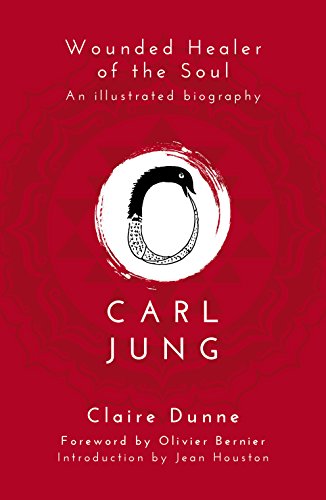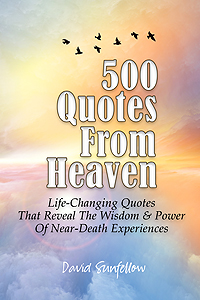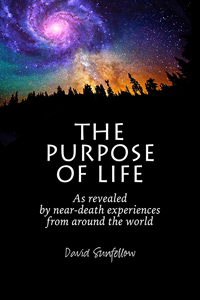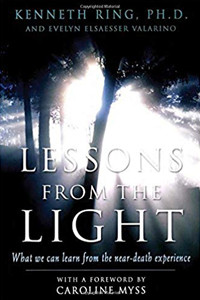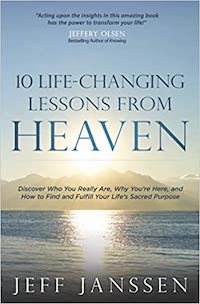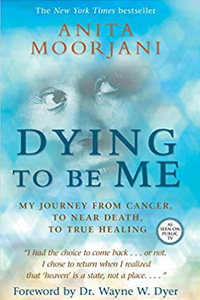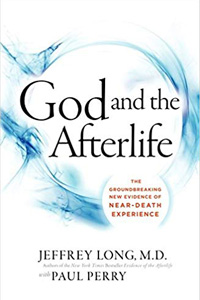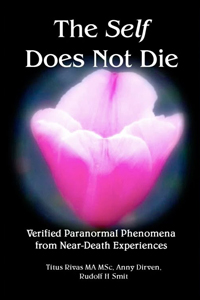![]()
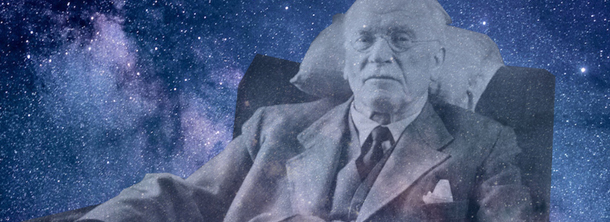
…………….
Introduction
By Kevin Williams
In a hospital in Switzerland in 1944, the world-renowned psychiatrist Carl G. Jung, had a heart attack and then a near-death experience. His vivid encounter with the light, plus the intensely meaningful insights led Jung to conclude that his experience came from something real and eternal. Jung’s experience is unique in that he saw the Earth from a vantage point of about a thousand miles above it. His incredibly accurate view of the Earth from outer space was described about two decades before astronauts in space first described it. Subsequently, as he reflected on life after death, Jung recalled the meditating Hindu from his near-death experience and read it as a parable of the archetypal Higher Self, the God-image within. Carl Jung, who founded analytical psychology, centered on the archetypes of the collective unconscious. The following is an excerpt from his autobiography entitled Memories, Dreams, Reflections describing his near-death experience.
…………….
Carl Jung’s Near-Death Experience
By Carl Jung
From Memories, Dreams, Reflections
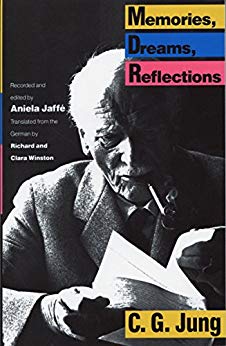 The beginning of 1944 I broke my foot, and this misadventure was followed by a heart attack. In a state of unconsciousness, I experienced deliriums and visions which must have begun when I hung on the edge of death and was being given oxygen and camphor injections. The images were so tremendous that I myself concluded that I was close to death. My nurse afterward told me:
The beginning of 1944 I broke my foot, and this misadventure was followed by a heart attack. In a state of unconsciousness, I experienced deliriums and visions which must have begun when I hung on the edge of death and was being given oxygen and camphor injections. The images were so tremendous that I myself concluded that I was close to death. My nurse afterward told me:
“It was as if you were surrounded by a bright glow.”
That was a phenomenon she had sometimes observed in the dying, she added. I had reached the outermost limit, and do not know whether I was in a dream or an ecstasy. At any rate, extremely strange things began to happen to me.
It seemed to me that I was high up in space. Far below I saw the globe of the Earth, bathed in a gloriously blue light. I saw the deep blue sea and the continents. Far below my feet lay Ceylon, and in the distance ahead of me the subcontinent of India. My field of vision did not include the whole Earth, but its global shape was plainly distinguishable and its outlines shone with a silvery gleam through that wonderful blue light. In many places the globe seemed colored, or spotted dark green like oxidized silver. Far away to the left lay a broad expanse — the reddish-yellow desert of Arabia; it was as though the silver of the Earth had there assumed a reddish-gold hue. Then came the Red Sea, and far, far back — as if in the upper left of a map — I could just make out a bit of the Mediterranean. My gaze was directed chiefly toward that. Everything else appeared indistinct. I could also see the snow-covered Himalayas, but in that direction it was foggy or cloudy. I did not look to the right at all. I knew that I was on the point of departing from the Earth.
Later I discovered how high in space one would have to be to have so extensive a view — approximately a thousand miles! The sight of the Earth from this height was the most glorious thing I had ever seen.
After contemplating it for a while, I turned around. I had been standing with my back to the Indian Ocean, as it were, and my face to the north. Then it seemed to me that I made a turn to the south. Something new entered my field of vision. A short distance away I saw in space a tremendous dark block of stone, like a meteorite. It was about the size of my house, or even bigger. It was floating in space, and I myself was floating in space.
I had seen similar stones on the coast of the Gulf of Bengal. They were blocks of tawny granite, and some of them had been hollowed out into temples. My stone was one such gigantic dark block. An entrance led into a small antechamber. To the right of the entrance, a black Hindu sat silently in lotus posture upon a stone bench. He wore a white gown, and I knew that he expected me. Two steps led up to this antechamber, and inside, on the left, was the gate to the temple. Innumerable tiny niches, each with a saucer-like concavity filled with coconut oil and small burning wicks, surrounded the door with a wreath of bright flames. I had once actually seen this when I visited the Temple of the Holy Tooth at Kandy in Ceylon; the gate had been framed by several rows of burning oil lamps of this sort.
As I approached the steps leading up to the entrance into the rock, a strange thing happened: I had the feeling that everything was being sloughed away; everything I aimed at or wished for or thought, the whole phantasmagoria of earthly existence, fell away or was stripped from me — an extremely painful process. Nevertheless something remained; it was as if I now carried along with me everything I had ever experienced or done, everything that had happened around me. I might also say: it was with me, and I was it. I consisted of all that, so to speak. I consisted of my own history and I felt with great certainty: this is what I am. I am this bundle of what has been and what has been accomplished.
This experience gave me a feeling of extreme poverty, but at the same time of great fullness. There was no longer anything I wanted or desired. I existed in an objective form; I was what I had been and lived. At first the sense of annihilation predominated, of having been stripped or pillaged; but suddenly that became of no consequence.
Everything seemed to be past; what remained was a “fait accompli,” without any reference back to what had been. There was no longer any regret that something had dropped away or been taken away. On the contrary: I had everything that I was, and that was everything.
Something else engaged my attention: as I approached the temple I had the certainty that I was about to enter an illuminated room and would meet there all those people to whom I belong in reality. There I would at last understand — this too was a certainty — what historical nexus I or my life fitted into. I would know what had been before me, why I had come into being, and where my life was flowing. My life as I lived it had often seemed to me like a story that has no beginning and end. I had the feeling that I was a historical fragment, an excerpt for which the preceding and succeeding text was missing. My life seemed to have been snipped out of a long chain of events, and many questions had remained unanswered. Why had it taken this course? Why had I brought these particular assumptions with me? What had I made of them? What will follow? I felt sure that I would receive an answer to all the questions as soon as I entered the rock temple. There I would meet the people who knew the answer to my question about what had been before and what would come after.
While I was thinking over these matters, something happened that caught my attention. From below, from the direction of Europe, an image floated up. It was my doctor, or rather, his likeness — framed by a golden chain or a golden laurel wreath. I knew at once:
“Aha, this is my doctor, of course, the one who has been treating me. But now he is coming in his primal form, as a “basileus of Kos.” [1]
In life he was an avatar of this basileus, the temporal embodiment of the primal form, which has existed from the beginning. Now he is appearing in that primal form.
Presumably I too was in my primal form, though this was something I did not observe but simply took for granted. As he stood before me, a mute exchange of thought took place between us. The doctor had been delegated by the Earth to deliver a message to me, to tell me that there was a protest against my going away. I had no right to leave the Earth and must return. The moment I heard that, the vision ceased.
I was profoundly disappointed, for now it all seemed to have been for nothing. The painful process of defoliation had been in vain, and I was not to be allowed to enter the temple, to join the people in whose company I belonged.
In reality, a good three weeks were still to pass before I could truly make up my mind to live again. I could not eat because all food repelled me. The view of city and mountains from my sickbed seemed to me like a painted curtain with black holes in it, or a tattered sheet of newspaper full of photographs that meant nothing. Disappointed, I thought:
“Now I must return to ‘the box system’ again.”
For it seemed to me as if behind the horizon of the cosmos a three-dimensional world had been artificially built up, in which each person sat by himself in a little box. And now I should have to convince myself all over again that this was important! Life and the whole world struck me as a prison, and it bothered me beyond measure that I should again be finding all that quite in order. I had been so glad to shed it all, and now it had come about that I — along with everyone else — would again be hung up in a box by a thread.
While I floated in space, I had been weightless, and there had been nothing tugging at me. And now all that was to be a thing of the past! I felt violent resistance to my doctor because he had brought me back to life. At the same time, I was worried about him.
“His life is in danger, for heaven’s sake! He has appeared to me in his primal form! When anybody attains this form it means he is going to die, for already he belongs to the ‘greater company’!”
Suddenly the terrifying thought came to me that Dr. H. would have to die in my stead. I tried my best to talk to him about it, but he did not understand me. Then I became angry with him:
“Why does he always pretend he doesn’t know he is a basileus of Kos? And that he has already assumed his primal form? He wants to make me believe that he doesn’t know!”
That irritated me. My wife reproved me for being so unfriendly to him. She was right; but at the time I was angry with him for stubbornly refusing to speak of all that had passed between us in my vision:
“Damn it all, he ought to watch his step. He has no right to be so reckless! I want to tell him to take care of himself.”
I was firmly convinced that his life was in jeopardy. In actual fact I was his last patient. On April 4, 1944 (4/4/44), I still remember the exact date I was allowed to sit up on the edge of my bed for the first time since the beginning of my illness, and on this same day Dr. H. took to his bed and did not leave it again. I heard that he was having intermittent attacks of fever. Soon afterward he died of septicemia. He was a good doctor; there was something of the genius about him. Otherwise he would not have appeared to me as a prince of Kos.
During those weeks I lived in a strange rhythm. By day I was usually depressed. I felt weak and wretched, and scarcely dared to stir. Gloomily, I thought:
“Now I must go back to this drab world.”
Toward evening I would fall asleep, and my sleep would last until about midnight. Then I would come to myself and lie awake for about an hour, but in an utterly transformed state. It was as if I were in an ecstasy. I felt as though I were floating in space, as though I were safe in the womb of the universe in a tremendous void, but filled with the highest possible feeling of happiness.
“This is eternal bliss,” I thought. “This cannot be described; it is far too wonderful!”
Everything around me seemed enchanted. At this hour of the night the nurse brought me some food she had warmed for only then was I able to take any, and I ate with appetite. For a time it seemed to me that she was an old Jewish woman, much older than she actually was, and that she was preparing ritual kosher dishes for me. When I looked at her, she seemed to have a blue halo around her head. I myself was, so it seemed, in the Pardes Rimmonim, the garden of pomegranates, [2] and the wedding of Tiferet with Malchut was taking place. Or else I was Rabbi Simeon bar Yochai, whose wedding in the afterlife was being celebrated. It was the mystic marriage as it appears in the Cabbalistic tradition. I cannot tell you how wonderful it was. I could only think continually:
“Now this is the garden of pomegranates! Now this is the marriage of Malchuth with Tifereth!” [2]
I do not know exactly what part I played in it. At bottom it was I myself: I was the marriage. And my beatitude was that of a blissful wedding.
Gradually the garden of pomegranates faded away and changed. There followed the Marriage of the Lamb, in a Jerusalem festively bedecked. I cannot describe what it was like in detail. These were ineffable states of joy. Angels were present, and light. I myself was the “Marriage of the Lamb.”
That, too, vanished, and there came a new image, the last vision. I walked up a wide valley to the end, where a gentle chain of hills began. The valley ended in a classical amphitheater. It was magnificently situated in the green landscape. And there, in this theater, the hierosgamos was being celebrated. Men and women dancers came onstage, and upon a flower-decked couch All-father Zeus and Hera consummated the mystic marriage, as it is described in the Iliad.
All these experiences were glorious. Night after night I floated in a state of purest bliss:
“thronged round with images of all creation (from “Faust,” Part Two.)”
Gradually, the motifs mingled and paled. Usually the visions lasted for about an hour; then I would fall asleep again. By the time morning drew near, I would feel:
“Now gray morning is coming again; now comes the gray world with its boxes! What idiocy, what hideous nonsense! Those inner states were so fantastically beautiful that by comparison this world appeared downright ridiculous.”
As I approached closer to life again, they grew fainter, and scarcely three weeks after the first vision they ceased altogether.
It is impossible to convey the beauty and intensity of emotion during those visions. They were the most tremendous things I have ever experienced. And what a contrast the day was: I was tormented and on edge; everything irritated me; everything was too material, too crude and clumsy, terribly limited both spatially and spiritually. It was all an imprisonment, for reasons impossible to divine, and yet it had a kind of hypnotic power, a cogency, as if it were reality itself, for all that I had clearly perceived its emptiness. Although my belief in the world returned to me, I have never since entirely freed myself of the impression that:
…this life is a segment of existence which is enacted in a three-dimensional box-like universe especially set up for it.
There is something else I quite distinctly remember. At the beginning, when I was having the vision of the garden of pomegranates, I asked the nurse to forgive me if she were harmed:
“There was such sanctity in the room,” I said, “that it might be harmful to her.”
Of course she did not understand me. For me the presence of sanctity had a magical atmosphere; I feared it might be unendurable to others. I understood then why one speaks of the odor of sanctity, of the “sweet smell” of the Holy Ghost. This was it. There was a pneuma of inexpressible sanctity in the room, whose manifestation was the mysterium coniunctionis.
I would never have imagined that any such experience was possible. It was not a product of imagination. The visions and experiences were utterly real; there was nothing subjective about them; they all had a quality of absolute objectivity.
We shy away from the word “eternal,” but I can describe the experience only as the ecstasy of a non-temporal state in which present, past, and future are one. Everything that happens in time had been brought together into a concrete whole. Nothing was distributed over time, nothing could be measured by temporal concepts. The experience might best be defined as a state of feeling, but one which cannot be produced by imagination. How can I imagine that I exist simultaneously the day before yesterday, today, and the day after tomorrow? There would be things which would not yet have begun, other things which would be indubitably present, and others again which would already be finished and yet all this would be one. The only thing that feeling could grasp would be a sum, an iridescent whole, containing all at once expectation of a beginning, surprise at what is now happening, and satisfaction or disappointment with the result of what has happened. One is interwoven into an indescribable whole and yet observes it with complete objectivity.
I experienced this objectivity once again later on. That was after the death of my wife. I saw her in a dream which was like a vision. She stood at some distance from me, looking at me squarely. She was in her prime, perhaps about thirty, and wearing the dress which had been made for her many years before by my cousin the medium. It was perhaps the most beautiful thing she had ever worn. Her expression was neither joyful nor sad, but, rather, objectively wise and understanding, without the slightest emotional reaction, as though she were beyond the mist of affects. I knew that it was not she, but a portrait she had made or commissioned for me. It contained the beginning of our relationship, the events of fifty-three years of marriage, and the end of her life also. Face to face with such wholeness one remains speechless, for it can scarcely be comprehended.
The objectivity which I experienced in this dream and in the visions is part of a completed individuation. It signifies detachment from valuations and from what we call emotional ties. In general, emotional ties are very important to human beings. But they still contain projections, and it is essential to withdraw these projections in order to attain to oneself and to objectivity. Emotional relationships are relationships of desire, tainted by coercion and constraint; something is expected from the other person, and that makes him and ourselves unfree. Objective cognition lies hidden behind the attraction of the emotional relationship; it seems to be the central secret. Only through objective cognition is the real coniunctio possible.
After the illness a fruitful period of work began for me. A good many of my principal works were written only then. The insight I had had, or the vision of the end of all things, gave me the courage to undertake new formulations. I no longer attempted to put across my own opinion, but surrendered myself to the current of my thoughts. Thus one problem after the other revealed itself to me and took shape.
Something else, too, came to me from my illness. I might formulate it as an affirmation of things as they are: an unconditional “yes” to that which is, without subjective protests acceptance of the conditions of existence as I see them and understand them, acceptance of my own nature, as I happen to be. At the beginning of the illness I had the feeling that there was something wrong with my attitude, and that I was to some extent responsible for the mishap. But when one follows the path of individuation, when one lives one’s own life, one must take mistakes into the bargain; life would not be complete without them. There is no guarantee not for a single moment that we will not fall into error or stumble into deadly peril. We may think there is a sure road. But that would be the road of death. Then nothing happens any longer at any rate, not the right things. Anyone who takes the sure road is as good as dead.
It was only after the illness that I understood how important it is to affirm one’s own destiny. In this way we forge an ego that does not break down when incomprehensible things happen; an ego that endures, that endures the truth, and that is capable of coping with the world and with fate. Then, to experience defeat is also to experience victory. Nothing is disturbed neither inwardly nor outwardly, for one’s own continuity has withstood the current of life and of time. But that can come to pass only when one does not meddle inquisitively with the workings of fate.
I have also realized that one must accept the thoughts that go on within oneself of their own accord as part of one’s reality. The categories of true and false are, of course, always present; but because they are not binding they take second place. The presence of thoughts is more important than our subjective judgment of them. But neither must these judgments be suppressed, for they also are existent thoughts which are part of our wholeness.
…………….
Footnotes:
[1] Basileus was the king (i.e. “basileus”) of Kos – a small Greek island on the Aegean Sea. The island of Kos was famous in antiquity as the site of the temple of Asklepios, and was the birthplace of Hippocrates.
[2] Pardes Rimmonim is the title of an old Cabbalistic tract by Moses Cordovero (sixteenth century). In Cabbalistic doctrine Malchuth and Tifereth are two of the ten spheres of divine manifestation in which God emerges from his hidden state. They represent the female and male principles within the Godhead.
…………….
“Matter Of Heart” is a compelling and inspiring 1985 film portrait of Carl Gustav Jung, a man whose extraordinary genius and humanity reached far beyond the sometimes exclusive realm of psychiatry into redefining the essential nature of who we are and what we hope to become. More than a linear biography, the film presents a fuller perspective on this analyst, healer, friend and mentor, through the skillful interweaving of rare home movies, valuable archival footage and a wealth of interviews with such notables as Sir Laurens van der Post, Marie-Louise von Franz and Joseph Henderson, M.D.
The life and thinking of the great Swiss psychiatrist, Carl Gustav Jung, is examined. Interviews are done with those who knew him, most of whom were analyzed by him and very often became analysts themselves. Jung’s own words appear on screen, and archive footage of Jung himself is shown. We learn aspects of his private life, including his relationship with his wife, Emma, and his mistress, Toni Wolff. But mostly we learn of his philosophy, sometimes mystical in nature, regarding the collective unconscious, the ego-personality, anima and animus, and more.
…………….
Question: “Do you believe in God?”
Carl Jung: “I know. I don’t need to believe. I know.”
…
“We need more psychology. We need more understanding of human nature because the only real danger that exists, is man himself. He is the great danger. And we are pitifully unaware of it. We know nothing of man; far too little. His psyche should be studied because we are the origin of all coming evil.”
…………….
Carl Jung: Wounded Healer of the Soul
By Claire Dunne
Amazon Description:
This is the first fully-illustrated biography of one of the greatest thinkers of the 20th century, famous for his pioneering exploration of dreams, the unconscious, and spirituality.
Carl Jung continues to be revered today as a true revolutionary who helped to shape psychology, provided a bridge between Western and Eastern spirituality, and brought into general awareness such fundamental concepts as archetypes, the collective unconscious, and synchronicity. In this important book, Claire Dunne chronicles Jung’s journey of self-discovery from a childhood filled with visions both terrifying and profound, through his early professional success, to his rediscovery of spirituality in mid-life. Special attention is paid to the tumultuous relationships between Jung and Sigmund Freud, the unconventional yet vital role performed by his colleague, Toni Wolff, and the revelatory visions Jung experienced following a close brush with death.
The words of Jung himself and those who shared his work and private life are shared verbatim, connected by Claire Dunne’s lively and accessible commentary and by an evocative array of illustrations including photographs of Jung, his associates, and the environments in which he lived and worked, as well as art images both ancient and contemporary that reflect Jung’s teachings. Jung emerges as a healer whose skills arose from having first attended to the wounds in his own soul.
This is an essential work of reference as well as a fascinating and entertaining read for everyone interested in psychology, spirituality, and personal development.
…………….
…………….
…………….
…………….
Part I: Jung’s Prophetic Visions
Jungian Center for Spiritual Studies
January 2012
Carl Jung was known for many things: his work with dreams; his early work as a psychiatrist with association experiments leading to the concept of the “complex,” work that brought him to the attention of Sigmund Freud; his interest in archetypes, which became such a feature of his brand of psychology that it often is labeled “archetypal psychology.” What is not so well known is Jung’s very keen intuitive nature, which manifested in his quick assessment of his patients’ conditions and, outside the clinical arena, in both his personal life and his role as a public figure.
Intuition is that function that allows us to see around the corner of the future. Jung experienced this repeatedly in his personal life. In 1896, when he was 21 years old and living in Basel as a medical student, Jung was asked by his mother to pay a social call on an old family friend, Frau Rauschenbach. During this visit Jung had a fleeting glimpse of a young girl and he knew intuitively that he had seen his future wife. This was highly improbable, given that Emma Rauschenbach was then only 14, the daughter of a rich industrial family, and he was an impoverished medical student with many years of education ahead of him. But Jung never wavered and, once he achieved financial independence, he courted her persistently and married her in 1903.
Nineteen years later, in November of 1922, Jung had a dream in which his father (who had died in 1896) came to him with questions about marital psychology. At the time Jung found the dream obscure. But two months later, he had a disturbing dream, which he recounted in his autobiography, Memories, Dream, Reflections:
“I was in a dense, gloomy forest; fantastic, gigantic boulders lay about among huge jungle-like trees. It was a heroic, primeval landscape. Suddenly I heard a piercing whistle that seemed to resound through the whole universe. My knees shook. Then there were crashings in the underbrush, and a gigantic wolfhound with a fearful, gaping maw burst forth. At the sight of it, the blood froze in my veins. It tore past me, and I suddenly knew: the Wild Huntsman had commanded it to carry away a human soul. I awoke in deadly terror,…”
The following morning Jung got news that his mother had suddenly died, and he then remembered the dream of two months earlier and understood that in that dream his father had sent him a warning.
Another example of Jung’s intuition arose from his habit of painting mandalas. When he did so, Jung operated in what I have referred to as “allow mode.” In this mode, one’s intuition emerges out of the end of the pen or brush, without intermediation by the conscious mind. One mandala Jung painted in 1928 developed a Chinese character and Jung was puzzled at this. Within a few weeks he was approached by a Sinologist, Richard Wilhelm, who asked Jung to write a psychological commentary on The Secret of the Golden Flower, a Taoist-alchemical treatise.
A final example of Jung’s intuition operating in his personal life was his initial meeting in 1933 with Marie-Louise von Franz, who was to become one of his most diligent students, analysands and co-workers. The meeting came about through Jung’s interest in getting to know more about the young people of the day. Von Franz was the only girl in a party of 8 that Jung hosted with lunch and supper and, as he spoke to them of his psychology, he felt certain that von Franz had something to do with alchemy. His intuition prefigured reality a year in the future: In 1934 von Franz became Jung’s analysand and translator for him of Greek and Latin alchemical texts. Many years later, she wrote Alchemy, one of the definitive texts on alchemy and Jungian psychology.
Jung’s intuition was no less impressive about collective situations. In 1913, Jung sensed the “atmosphere” of Europe was “darkening,” and there was “something in the air,” something that felt oppressive in concrete reality, not just in his unconscious. In October of that year, Jung had a prophetic vision which he described in his memoir:
“… I was suddenly seized by an overpowering vision: I saw a monstrous flood covering all the northern and low-lying lands between the North Sea and the Alps. When it came up to Switzerland I saw that the mountains grew higher and higher to protect our country. I realized that a frightful catastrophe was in progress. I saw the mighty yellow waves, the floating rubble of civilization, and the drowned bodies of uncounted thousands. Then the whole sea turned to blood. This vision lasted about an hour….”
Two weeks passed; then the vision recurred, under the same conditions, even more vividly than before, and the blood was more emphasized. An inner voice spoke.
“Look at it well; it is wholly real and it will be so. You cannot doubt it.”
When Jung was asked later in the year what he thought were the prospects for Europe’s future, he replied that he “had no thoughts on the matter,” but added that he had seen rivers of blood. In the Spring of 1914 he had three dreams in which Europe was covered with ice and all the vegetation was killed by frost. World War I broke out 2 months after the last of the three dreams.
During the 1920’s, while most people gave “the Roaring Twenties” its name with their partying and blithe lifestyles, Jung grew more and more aware that the “carefree optimism” was a “groundless illusion.” He began to warn his students to avoid living in fantasy: he intuitively sensed the tension building and, while he did not then know just where it would manifest, Jung was sure there would eventually be another war. This was more than a decade before World War II began.
In 1958 Jung warned people that “an archetype was stirring in a way that was characteristic for ‘the end of an era.’” He knew of the lore in mundane astrology that posits a shift from the Piscean to the Aquarian age and Jung spoke of the upheavals and great changes we can expect during such a major transition. Few people had listened to Jung previously, when he warned of the coming of the two world wars so he had no illusions that he would be heard in 1958, when Cold War concerns so preoccupied the collective mind. But he felt compelled to speak up.
Jung’s gravest warning came three years later, on his deathbed. Reflecting the concern for the well-being of the world that had been a constant feature of his life, Jung’s waning energies were focused not on his children, his psychology, the Institute he founded or his own reputation. Rather, he looked to the future of the world after his death. On May 30, 1961, eight days before he died, Jung dictated to his daughter his last visions, with instructions that the notes were to be given to Marie-Louise von Franz. The images were sobering:
“I see enormous stretches devastated, enormous stretches of the earth. But thank God, not the whole planet.”
And Jung made a drawing, with a caption under it that said, “The last 50 years of humanity.”
That was in 1961. Fifty years hence would be 2011. The date is interesting, given the Mayan prophecy that speaks of the end of an era in 2012. We have no indication in the historical record that Jung knew of the Mayan prophecies. That he got the same timetable as an ancient people might be another reflection of his keen intuition.
Jung’s last vision — foretelling the destruction of a large part (but not all) of the world — might leave us feeling gloomy, if not despairing. But that was not Jung’s intention: he always worked to support healing, for people and planet and, as part of that intention, he offered us a road map for change. This road map can set his final visions in a larger context. An explication of his road map is the focus of Part II of this essay, which will appear in this blog space next month.
…………….
Part 2: Alchemy and Its Phases – A Road Map for Individuals and Cultures
Jungian Center for Spiritual Studies
February 2012
“Alchemy.” The word conjures up medieval men hunched over flasks and fires trying to turn lead into gold. Historians of science regard alchemy as the precursor of modern chemistry. The dictionary defines it as “a combination of chemistry and magic studied in the Middle Ages, especially the search for a process by which cheaper metals could be turned into gold and silver…” It was part of Jung’s genius, born out of his respect for ancient ways and wisdom traditions, to recognize that the medieval alchemists were about something much more profound than making gold out of lead.
Rather than metallurgical transformation, alchemy is about the process of personal transformation. Lead is symbolic of the basic unconscious state that we’re in when we come into the world, and the gold is the achievement we reach when we have developed in ourselves what Jung called “individuation,” that is, when we have become fully and truly who we are meant to be. This process of change takes many forms, involves many processes and takes us through many phases as we work to individuate.
Jung and his followers (especially Marie-Louise von Franz) describe the phases of alchemical change using the terms developed by the early alchemists. These medieval researchers were fluent in the scholarly language of the day, Latin, hence the terms show up in forms that are foreign to the ears of most contemporary Americans.
The alchemical change process occurs in four major phases: the nigredo, the albedo, the rubedo and the citrinitas. In this Part II we will define and describe each phase in terms of an individual’s experiences. Then we will apply the phase on the collective level, in a general way. In Part III we will relate the phases to our current reality, with reference to specific events and phenomena we are witnessing now, and then look into the future.
The Nigredo
The first of the phases is dark, dismal, a very black time, well-labeled the nigredo, which comes from a Latin word (niger) meaning “black” or “dark.” For the person in this phase, life is not pleasant, as it is full of confusion and bewilderment, disorientation, sickness of spirit and confrontations with the shadow. Jealousy, envy, irritability, anxiety, self-righteousness, greed, melancholy and inflation are just some of the panoply of feelings that show up during this most difficult of the phases.
A variety of alchemical processes are part of this time, including:
the putrefactio, when we come to recognize some component of our existence is putrid, or rotten, with little or no energy left to feed our life.
the mortificatio, “death” — of people, things, parts of ourselves, in a metaphorical or (more rarely) literal sense — which leaves us with a sense of loss and grieving.
the calcinatio, “burning” or the “refiner’s fire” spoken of in the Old Testament, the process in which we experience the frustration of our desire nature, with the purpose of purifying or “refining” our will.
the solutio, or dissolution of one or more of the elements of our existence that give our life structure, a process during which we are flooded with affect.
These are just a few of the more than dozen processes that alchemists recognized and described. Since each alchemist wrote from his/her own experience, each alchemical text describes the order, sequence and processes differently, making close comparison difficult. But Jung saw the close correlation between their varied descriptions and what he himself experienced in his own development and in that of his patients.
The nigredo is the phase when we are still operating mostly unconsciously. Our complexes are mostly autonomous in this beginning phase. As a result, we suffer more acutely than in the later phases.
The Albedo
The term albedo comes from the Latin albus, meaning “white” or “bright.” Things begin to feel lighter, “brighter” in this phase, compared to the previous misery of the nigredo. The work of this phase is to become aware of our “contrasexual side” and make the acquaintance of our “inner partner.”
As we wrestle with our complexes and strive to domesticate them, we experience strong passions and bitter hostilities, within and without, in dealings with others (often those closest to us). The challenge is to balance the opposites and achieve an integration of the animus/anima. In the process of the sublimatio, we become more objective, able to rise above situations to see them from a transcendent perspective. In developing a conscious relation to the inner man (for a woman) or woman (for a man), we redeem the body and matter, and come to experience what the great 13th century abbess, Hildegard of Bingen, called benedicta viriditas, the blessedness of being alive.
In the albedo phase we work to bring up from the unconscious (that is, we “redeem”) attitudes and feelings about ourselves, our bodies, our sexuality, the opposite sex and the host of feelings we have around embodiment itself. The purpose here? To come ultimately to a deeper level of wholeness and a greater appreciation of life on the physical plane.
The Rubedo
The third phase means “reddening” in Latin and just as our face reddens in the process of blushing, so we experience a surge of renewal in the rubedo phase. After confronting the shadow in the nigredo and wrestling with our inner opposite sex in the albedo, we come to the third phase more able to hold the tension of opposites (good and bad, male and female). The process of the sublimatio has led to the development of new attitudes, and the deus absconditus (the hidden god within) becomes known. Through long-term conscious suffering the ego now becomes conscious of the Self: we begin to recognize the wise source of inner guidance. After numerous experiences of “crucifixion” the ego begins, in this rubedo phase, to subordinate itself to an authority higher than it. The Self becomes actualized, rather than just a potential within. And we begin to be able to sustain the paradox of recognizing our divine nature without identifying with it.
By this point in the spiritual journey life is feeling very different from where we were, and what we were feeling, when we set out in the nigredo phase. By this penultimate phase, life seems to be working better, we feel better — as if we are “getting our act together.” Stay the course and we come to the final phase.
The Citrinitas
The source of our English word for the yellow-green gemstone “citrine,” citrinitas is the alchemical term for the final phase of transformation, the fulfillment of the opus, or work, the metaphorical “gold.” A new day dawns. A new way of being lies before us, as we recognize ourselves as filii macrocosmi (children of the Universe). Fertilized by spirit, illuminated by repeated transmutations of our inner dross into the “gold” of consciousness, we participate consciously in the process of creation in this final phase. We consciously take up our role as co-creators with the Divine.
These four phases — nigredo, albedo, rubedo, citrinitas — describe the stages of alchemical change not only on the individual level. Jung recognized that “the collective psyche shows the same pattern of change as the psyche of the individual.” This being so, collective life would manifest the following:
in the nigredo phase: fires, floods, epidemics and natural disasters, plane crashes and other events that leave hundreds or thousands dead; inflation, in the economic sense of rising prices; the discovery of rot and corruption in the public sphere, in corporations and in government; greed, with the basic motivation being money, with people being “bought” in a variety of ways, and the political system held hostage by the plutocrats or moneyed interests; large segments of the population not understanding what’s going on in the world, experiencing confusion, disorientation, feelings of being “out of the loop,” shut out of public life; sickness of spirit, with many signs of spiritual malaise, e.g. widespread substance abuse, domestic violence, child abuse, sexual violence; anxiety and irritability, along with a rash of psychosomatic illnesses, a rise in mental illness and more minor forms of madness like “road rage.”
in the albedo phase: confrontations between the sexes; public debates about the role of women in the public sphere; protests and agitation for more equal rights for women and minorities; more push to integrate women and minorities into the mainstream of our collective life
in the rubedo phase: more discussion of unity, the interdependence of all beings (not just human beings), the preciousness of life, a growing reverence for life and Earth, our planet that sustains our life; and the appearance of new attitudes and concerns (e.g. the growing planetary awareness of global warming)
in the citrinitas phase: new ways of being and living that create a world that works for everyone, all beings, not just humans; the rise of a way of living and working that sustains natural systems, that provides spiritual fulfillment and economic justice to all. Visionaries in indigenous cultures hundreds of years ago have provided descriptions of this phase as a time of: peace (all sources of conflict are gone); union (all recognize that we are one); life directed by the Creator, with everyone understanding the cosmic plan; everyone being able to communicate with everyone and everything else (i.e. telepathy is the usual way communication occurs); a single currency, with no governments; love and joy being experienced all the time.
In general terms, this is how we might expect the alchemical stages to show up on the collective level. In Part III we get specific. Was Jung right? Can we see actual events in our current reality that might suggest just where we are along the alchemical road map? We will address these questions in our March blog posting.
…………….
Part 3: Our Current Situation in an Alchemical Context
Jungian Center for Spiritual Studies
March 2012
In this part we will examine the 4 alchemical phases with reference to specific events in the daily newspapers that provide us with insights into the phases underway in this transitional time. Then we will consider what the next few years might hold for us, using alchemy as a guide to the future.
Pick up the daily newspaper and what do we read about? Major forest fires burning thousands of acres and leaving hundreds of people homeless. Massive hurricanes dissolving beaches, breaking down structures, flooding whole cities. Tens of thousands dying in large earthquakes and terrorist attacks. Currencies losing their value. The revelations of corruption at all levels of business and government, as Governors and Senators are forced from office for malfeasance, bribery, or other “high crimes and misdemeanors;” heads of state castigating other heads of state as “the axis of evil” and refusing to engage them on the world stage; Wall Street tycoons getting huge paychecks, CEOs claiming big bonuses, “golden parachutes” and salaries hundreds of times larger than those of ordinary workers; hot shot “dealmakers” fancying themselves “Masters of the Universe;” confusion, bewilderment, disorientation and melancholy as tens of thousands of people lose their homes in the mortgage crisis; hundreds of young people becoming addicted to drugs or alcohol each year; major banks collapsing, ratcheting up the anxiety level throughout our society.
Do we need to wonder what is going on? Clearly we are now in the nigredo stage as a society, experiencing the calcinatio (fires), solutio (floods), mortificatio (dying), inflation (both economic and personal), the putrefactio (corruption), confrontation with the shadow (which George Bush projected out in seeing others as “evil”), greed, confusion, sickness of spirit, and anxiety. This is not a good time in our collective reality! Some elements of our society would have us believe it is the beginning of the end, that we will soon witness Armageddon or the Apocalypse.
But Jung reminds us that the nigredo is not meant to be the end. It is only a phase, the hardest phase, admittedly, but one that we are meant to grow through. Using alchemy as our road map, we can also see signs of the albedo, the phase after the nigredo.
We see the strong passions and bitter hostilities that are characteristic of the albedo phase in the Obama-Clinton exchanges during the Presidential primaries. Other examples of this are: the hostilities between Sunnis and Shi’ites in Iraq, between Tibetans and Chinese in Tibet, and between the Islamic jihadists and the U.S. military in Afghanistan. There is growing awareness of the need to balance opposites like home and work, work and play, in, for example, the studies of Anne Wilson Schaef and others on the dangers of addictions (e.g. workaholism). In the rise of feminism, gender studies on college campuses, and the women’s rights movement internationally we see growing attempts, on the collective level, to integrate animus and anima. In the rising awareness of holistic health, eating disorders and the value of diet in health maintenance we see the redemption of body and matter. The popularity of the books by Marion Woodman speaks to the growing concern with the body and its connection to soul. Finally, the environmental movement is the modern form of Hildegard’s benedicta viriditas, the blessedness of “greenness” and life on this planet.
Signs of the rubedo phase are just emerging in our collective experience. Renewal seems to be showing up in the growing number of people who are now working on healing themselves, including becoming conscious of the unconscious. New attitudes are appearing: there is more respect now being given to indigenous peoples and what they can offer us; more people are waking up to how global capitalism is destroying the planet; reverence is being given to Mother Earth in more places and more ways; the push for peace is growing as more people wake up to the reality that violence never solves anything; we are seeing a more conscious holding of the tension of opposites, as more people recognize the “clash of universalisms” and realize that gravity — and the Source of gravity — truly does work for everyone (even those who profess a different religious belief). As more people “authorize their own lives” they look within for direction and recognize the wisdom that their inner Divinity offers. Finally, we are hearing messages (even in media like television that usually pander to the lowest common denominator) reminding us “we’re all in this together,” and in such venues we are seeing nascent visions of unity. “Nascent” because this phase is just beginning to emerge on the collective level.
The nigredo, by contrast, is well underway. What does it suggest the next few years are likely to hold for us?
Our Possible Future in an Alchemical Context
The years ahead are likely to see widespread confusion — times when people really aren’t clear as to what’s happening. Disintegration — where things fall apart — is also likely, in what George Land called the “breakdown” time (which makes possible the “breakthrough” later on). Another likely part of our future is aggression: anger against oneself, as well as with other people. All sorts of base passions are likely to rise up: rage and jealousy, resentment and frustration.
There is likely to be lots of death. In the mortificatio people experience the death of various aspects of themselves or the death of some important people in their lives, or the death of a phase of life, or the death of a job. Given the current round of layoffs reported daily in the news, we are witnessing lots of mortificatio now. Deaths from fires, earthquakes, typhoons, hurricanes and tornados show up on the evening news with distressing regularity. We might also see widespread deaths from epidemics.
There are lots of dangers in the collective form of the nigredo, and these dangers are likely to continue until we have moved out of this phase. There are demonic energies at work, energies from our unreconstructed side, energies from those people in the collective who would cause disintegration and disharmony and who would try to break down whatever is whole and healing. This is part of our confronting the shadow in ourselves and in our culture.
There is, in this time, lots of projection of the shadow. I noted George Bush as a stellar example of this, with all his talk of the “axis of evil” in North Korea, Iran, Saddam Hussein’s Iraq, and Osama bin Laden. We are projecting the shadow out on to these people, rather than recognizing it in ourselves. Unless or until we, as a collective become more reflective and introspective, we are likely to continue to see the shadow outside.
Another quality of the nigredo phase is emotional outbursts, and it is very likely that we will see further expressions of anger and rage as more people become confused, disoriented and anxious. Many are likely to be highly emotional and volatile.
More and more people will recognize the old ways are inadequate (we have seen some of this already, in the enthusiasm with which people greeted Obama’s call for change). In the nigredo, on the individual level, it does eventually dawn on the person that the old way in which s/he has been living probably isn’t working very well anymore. In many cases people at this point fall into psychological depression. On the collective level it is very likely that we will fall into economic depression. Given the gross materialism of American culture, I think it is going to take something as severe as the Depression of the 1930’s to jog people out of the warped values our culture is mired in.
So, for those very much identified with their stuff, there is likely to be a sickness of spirit, manifested perhaps in acute despair. Many people will feel all is lost, all is gone, there is no hope etc. There may be suicides and homicides. A friend of mine recently lost his daughter when her husband discovered that his many millions of dollars had disappeared in the mortgage crisis. His response to that was to kill her and then jump off the Delaware Memorial Bridge. We are likely to see tragedies like this from people whose entire sense of identity is invested in material stuff.
Illusions are likely to be shattered. After 8 years of George Bush (with his 20% approval rating), there are not many people who still put their hopes in the federal government. It has become obvious that the federal government wouldn’t be able to find its way out of a paper bag. They’re certainly not going to save us. People looking to government for solutions will be disappointed and this may lead to uprisings and riots, perhaps even rebellion and revolution. Around the world people are likely to be forced by events to recognize that government does not have the solution, and this is not just in the United States. In general, governments are not going to be able to solve our problems. National governments are actually atavisms, that is, at a certain period of history they were appropriate but, as we have evolved collectively, as a global civilization, national governments are no longer appropriate. I think over the next 3 or 4 decades there will be growing recognition that national governments are yet another source of divisiveness and problems, being too big to solve local problems and too small to solve global problems.
There will be other illusions that have to be shattered as well. For example, Americans tend to think that we have the best country in the world, the best systems and all the answers. That illusion definitely has to be dispelled and years of neglect to our civic infrastructure may help to do this. We’re likely to see the breakdown of the systems that run the country: glitches in the electric grid, problems with transportation — subway systems, roads etc. We are already seeing this in Vermont where major bridges on federal highways (vital arteries, not back roads!) have been closed due to poor maintenance. This (and the enormous rise in the price of petroleum) will lead to widespread disruption in distribution systems and in the transportation of vital resources. In some locales there may be empty food shelves. If you live in an area very near farms and places where people can grow food this may not be as much of a problem. But in many of the major cities there will be problems from disrupted distribution chains.
The nigredo is a time when there is very little reflection or introspection, because the old mode of orientation to the outer world is still so entrenched. It’s only toward the end of this phase that the individual begins to make a habit of looking within. Then s/he becomes far more reflective and starts to wonder what’s going on at deeper levels. Prior to this the tendency is to try to figure out who can be blamed for the misery the person is experiencing.
On the collective level the early stage of the nigredo is likely to show up in accusations, of pointing the finger, of fixing blame on somebody or some group or agency of government. A current example is the Food and Drug Administration. We look to the FDA now to protect the safety and purity of our food and pharmaceuticals. So, in the face of e-coli outbreaks, contaminants in food and drugs, salmonella epidemics, etc. we want to find out who can be blamed.
The nigredo is not a pleasant time and prophecies from many sources warn us that it’s going to get worse before it gets better. As I noted in Part I, the last of Jung’s prophetic visions foretold the destruction of most, but not all, of the world. He felt this was 50 years in the future, which means he anticipated some sort of cataclysm in 2011. This date coincides with ancient Mayan prophecies that identify 2012 as the time of a major shift of perception. Some speak of this as “the end of time,” which might refer to the point at which human beings switch from living mostly out of the left brain (which is time-bound) to right-brain dominance (the right brain operates outside of linear time).
It will be very important in this nigredo phase, when things are going from bad to worse, that we remember this phase is not the end. It is merely a clearing-out phase. It is a phase meant to prepare us, as a society, for the albedo phase. If you are reading this blog posting you should be aware that you are doing so for a deeper reason than mere interest in the Jungian Center: on some level, whether you are conscious of it or not, you agreed to sign on to share this message with other people so that more and more people come to realize this is not the end. Although there may be mass destruction and global catastrophe, this is not meant to be the end. It is a transitional phase, just one phase (difficult, to be sure) but the necessary breakdown phase. It will clear away what has to be removed so that we can break through to a much better reality.
The nigredo prepares us for the albedo phase. As I noted earlier, in Part II, the albedo is easier than the nigredo. In the individual it is the time when a person begins to confront and deal very consciously with his or her contrasexual side. On the collective level this is likely to take the form of a re-evaluation and a re-appreciation of the feminine. The feminine, and women, will move much more into positions of equality, true equality with the masculine, with men. The feminine perspective will be integrated into all aspects of life. In doing this we will begin to differentiate our capacity to relate to our fellow human beings. We will resist falling into the herd phenomenon, and we will also have to work at transcending “bi-polar thinking,” i.e. seeing things in dichotomies, or the “us-them” way of thinking. In bi-polar thinking, it’s man versus woman. Rather than this “either-or” mode, we will have to learn to think more inclusively, with a “both-and” approach. As we learn to hold the tension of opposites we will see the emergence of what Jung called “the transcendent function,” the function that reconciles these opposites into the “mystic marriage,” where the animus and anima, the masculine and feminine, are integrated.
Given our thousands of years of history of bi-polar thinking, this new way will not be easy. It thwarts the will of the ego, which isn’t used to thinking like this. It isn’t used to treating the opposite gender in this way so there will be some struggle (especially for men), but it’s not going to be as difficult as the nigredo phase was. We can also anticipate that with the re-appreciation of the feminine will come a revering of Mother Nature, of planet Earth, and all things associated with The Mother. A real ecological consciousness will arise in people as part of the albedo phase on the collective level.
The albedo will eventually lead to the rubedo. This will be a breakthrough time. On the individual level it is a time when all the scattered pieces of life are accepted and integrated and we come to sense within the archetype of wholeness that, in the ancient world, was called the Anthropos. This is also the time when the body and matter are spiritualized. In other words, this is the phase when the individual recognizes that matter is not primary.
In our materialistic culture now we definitely operate under the assumption that matter is what’s real. This is an error, and people will begin to recognize this error in the next few years, during the nigredo phase, as their identification with matter and money and outer things falls away. The point of all the destruction in the nigredo phase is to get us to recognize that it is not matter that is primary: spirit is primary. We are fundamentally spiritual beings. While we are on earth we are having a physical experience. But we are not essentially matter. So, on the collective level in the rubedo phase, spirit will become recognized as primary and we will relinquish possessive attitudes. We won’t be so focused on “our” stuff; we won’t feel things have to be our “own.” Eventually there is likely to be complete sharing.
During the rubedo phase people will come more and more to recognize their inner divinity, the divine spark within them. In this stage of enlightenment matter will come to be sanctified. The Earth will be seen as sacred and we will begin to give respect to indigenous peoples’ sacred places and spaces. There will much more of a push for global peace and unity — the recognition that all peoples are in this world together.
In the final phase, the citrinitas, there will be no conflict. Peace will be the norm. The Hopi prophesy that everyone will be able to communicate telepathically, with animals as well as other humans. All limiting thought will be gone. Everyone will understand the cosmic plan and everyone will recognize our divinity as human beings. We will not believe in separation between humans and the world, or between people and their Creator. In other words, the current idea in Western civilization that humans are somehow separate from and superior to Nature — that they have “dominion” over Nature — will be recognized as an extremely destructive way of thinking and will be gone. Life will be directed by the Self (with a capital S). Life will not be ego-driven. The technologies that we use will serve the cosmos and the living Earth, and will not be driven by greedy corporations that have to constantly push stuff on to us to continue to expand their bottom line. Technologies will be very Earth-friendly. Love and joy will be experienced all the time. There will be no governments because there will be no need for governments. As Locke and Hobbes remind us, governments derive from a certain attitude or vision about the nature of human nature, and that, of course, will be seen in a very different way in the citrinitas phase, when the adaptation to a cosmic consciousness will be complete.
Conclusion
Why should we be hopeful as we look ahead? For several reasons: first, we must recognize that despair is disempowering, and the only thing that despair produces is more despair. The nigredo is likely to be a difficult time, but we must not fall into despair. The nigredo is just one phase and the others will be easier.
We should also remember that we have choices. John Perkins, the author of The World Is As You Dream It, reminds us that by the visions we set for reality we determine the kind of reality we have. We can choose to dream a positive dream or a positive vision for the future and the dream will make it so. If we choose to dream a negative dream, or if we choose to fall into despair, it’s going to worsen the conditions around us, and we could possibly put an end to the planet. This is a choice and it’s our choice to make. Each person counts here.
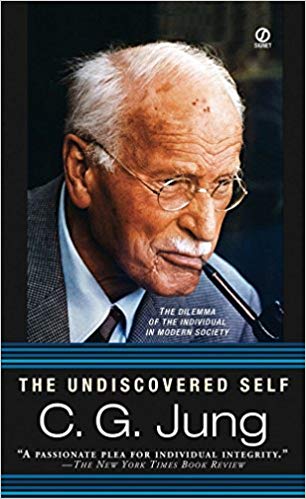 In The Undiscovered Self, which is one of the books Jung wrote for a lay audience, he said that each individual has to recognize that he or she could very well be the “makeweight,” that is, the crucial figure that tips us into a whole new mindset. Many decades later this was what Malcolm Gladwell called the “tipping point.” None of us knows who this crucial figure might be: it could very well be any one of us. If you are reading this blog posting, you are hereby put on notice that you count and you could be the crucial figure who tips us into a new reality.
In The Undiscovered Self, which is one of the books Jung wrote for a lay audience, he said that each individual has to recognize that he or she could very well be the “makeweight,” that is, the crucial figure that tips us into a whole new mindset. Many decades later this was what Malcolm Gladwell called the “tipping point.” None of us knows who this crucial figure might be: it could very well be any one of us. If you are reading this blog posting, you are hereby put on notice that you count and you could be the crucial figure who tips us into a new reality.
I am often asked “How do you think we’re going to get there?” In response I go back to 1989. There are a lot of people that don’t remember that period. A lot of my students weren’t even born in 1989. But in 1989 there was a massive transformation of Europe and not a single shot was fired. There was no violence at all, but at some point the countries of Eastern Europe recognized that they were no longer under subjugation. They could leave the Soviet bloc and the Soviet Union fell apart. Now how did that happen? It happened because there was a fundamental shift of attitude on the part of most of the people. I think that, in time, people are going to wake up — they will make a major shift in attitude — and will recognize that the reality we have now is fundamentally unsustainable, extremely unjust and ecologically destructive. And in this recognition, our current reality will loose its legitimacy.
There are a whole series of indigenous cultures, in addition to medieval alchemy, that provide us with descriptions of what we are going through now. They describe the lay of the land in this phase of our journey. These cultures and alchemy, like ancient maps, note “Here be dragons.” “This is a danger spot.” “This is going to be a difficult interval.” They lay out forks in the road. These forks are choice that we must make. As Yogi Berra said, “When you get to the fork in the road, take it!” But there are a lot of people in our culture now, and certainly in the years ahead, who will take that fork but then they’ll wander around looking for the knife and the spoon as well. In other words, they’re not going to make a choice. They’re going to be dithering. They will be very reluctant to move on to a new, more viable reality.
Native cultures and alchemy describe the destination that Nature intends us to reach. In other words, the fork that we are meant to choose is toward a better world, a world of peace, a world of environmental reclamation, a world of harmony, a world of wholeness. This is the fork that we’re meant to choose. As Jung would remind us, our role as individuals is to become more conscious of our responsibility, to come to recognize who we are, what we are meant to be, how we are meant to serve, and how we individually can work for a world that works for everyone.
The culture today would keep us disempowered. It wants you to be locked down into fear — fear of terrorists, fear of illegal aliens, fear of losing your job, fear of losing your house — all sorts of fears. You can choose to go down that path but I guarantee you your reality and your future will not be nice. You can also choose to recognize what the authorities are trying to do: people that are fearful are very much easier to control. Then you can say to yourself, “I’m not going to buy that! I’m not going to allow the powers that be to disempower me! I am going to claim my choice, as an individual, to begin to serve the new, better reality which is coming.” Armed with the road map of alchemy and Jung’s prophetic visions, you can be prepared for the challenges and exciting future that is in store for us.
…………….
Related Links:
• Wikipedia on Carl Jung
• The C. G. Jung Institute Zurich
• Jungian Center for the Spiritual Sciences
• Carl Jung Resources
• The C.G. Jung House
• Carl Jung Describes The Near-Death Experience Of One Of His Patients (pdf)
• Why It’s Important To Know About Shadow Issues And Work On Them
• Dream Basics
• Near-Death Experiences That Predict The End Of The World

